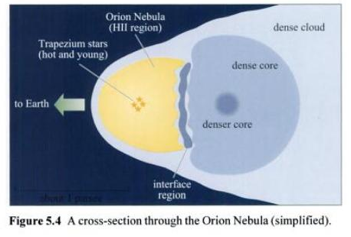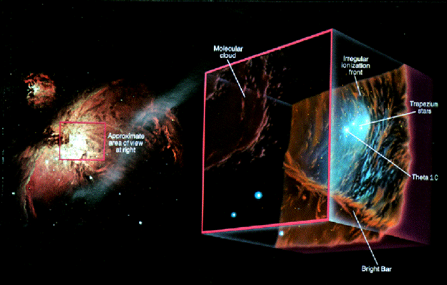
Orion Nebula & why uniformity is idealized
Blister HII Regions
HII regions don’t often occur in a uniform medium. When there are density inhomogeneities, they can cause asymmetries in the structure of the HII region. One such case is when HII regions develop at the edge of a molecular cloud. The result is that the HII region can burst through the molecular cloud’s surface, like a blister - hence these regions can be known as blister regions or champagne flows.
Observational connection
Observations of asymmetric HII regions may be due to inhomogeneities in the density of the gas. Blister type regions or champagne flows are examples of HII regions exhibiting this asymmetric structure.
Try it out
The size of the HII region is given at right. Using the fact that θ1 Ori C is an O7V star, with an effective temperature of 41000 K, find a range of parameters to date the Orion Nebula.
And check out this Hubble Space Telescope tour to explore more features of the Orion Nebula.
From “An Introduction to the Sun and Stars” - eds. Green & Jones

NASA/ESA/M.Robberto

The Orion Nebula - an HII Region

The Orion Nebula was the first HII region ever recorded, discovered in 1659 by Christiaan Huygens. Located in the Orion Nebula Complex, the Orion Nebula is ionized by stars in the Trapezium cluster, within it. Of these stars, the most massive is θ1 Ori C, believed to produce the bulk of the ionizing flux responsible for the HII region.
When we look at the Orion Nebula we find that it looks rather different from the Rosette Nebula, even though both are HII regions. What we observe isn’t a perfect Strömgren sphere, since it isn’t the same in all directions. While it may look circular, this is, in part, a projection effect because the nebula is located at the surface of the molecular cloud, as shown in the schematic at left. Its morphology is closer to a hemisphere than a sphere.
National Graphic
Orion Nebula: Size
The Orion Nebula is observed to be 65x60 arcmins on the sky, located 412pc away (1parsec (pc) = 3.086e18 cm), giving it a diameter of 7.8 pc.